Recent Commercial Posts
How Do I Stop a Toilet That Won’t Stop Flushing?
9/13/2023 (Permalink)
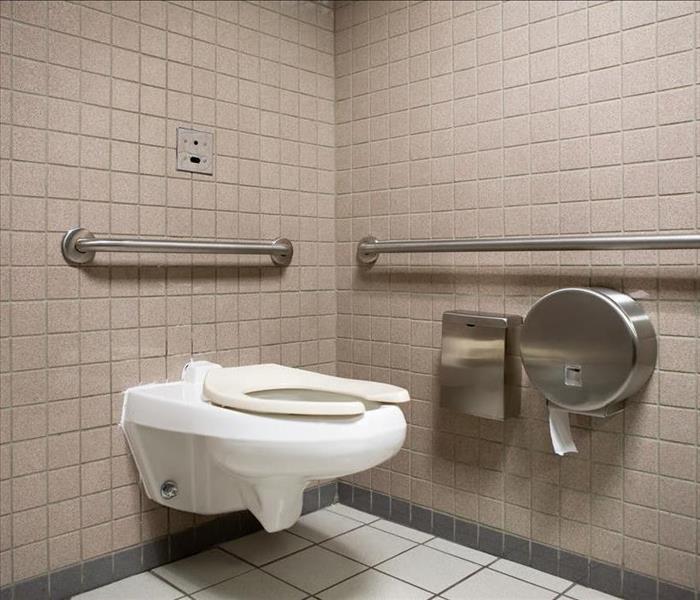 Avoid a toilet flood in Bountiful, UT.
Avoid a toilet flood in Bountiful, UT.
Running a business in Bountiful, UT, comes with various responsibilities, some of which can be quite an annoyance. A toilet overflow is terrible enough, but what about a commercial toilet with a faulty flushometer? As easy as they usually make life, like anything, things can sometimes go wrong with a flushometer. One common problem is the "never-ending flush," when the flushometer constantly runs water into the toilet with no sign of stopping. This can quickly waste hundreds of gallons of water and run your company's water bill through the roof. It can also take your only toilet out of commission for your employees and customers. Fortunately, it can often be an easy fix, so you probably won't have to worry about calling a plumber.
Fix a Faulty Flushometer To Avoid a Toilet Flood
These instructions are for repairing a manual flushometer. Taking these simple steps should solve your problem.
- Shut Off the Water
First, you must shut off the toilet's water supply. You will typically need a flathead screwdriver for this job. You should see a screwdriver slot on one side of the flushometer. If you don't see a screwdriver slot, it may be hidden under a decorative cover. In this case, you should be able to pry the lid off with little effort to access the screwdriver slot. This will help avoid a leak while you work, particularly with a constantly running toilet.
- Remove the Flushometer Lid
Next, you will need to remove the top lid of the flushometer. You will probably need a wrench to loosen the cover, but it should screw off with ease once it's loosened.
- Remove the Flange Cover
You will now need to remove the flange cover. This can sometimes get a little messy with the accumulation of water that will come out when you take the lid off. Be sure to have a towel on hand.
- Remove and Clean the Gasket
Under the flange cover, you will find a gasket. You will also probably notice a lot of sediment on the gasket. Remove the gasket and wash it thoroughly. Look closely, and you will see a weep hole built into the gasket. Although tiny, this hole is there for a reason and could be the main issue with your flushometer's poor performance; the weep hole helps control the suction of the toilet. To help avoid a toilet overflow, you'll need to clean the weep hole port with an unbent paperclip, needle, or some other object that is very small in width.
- Reinstall the Gasket and Reassemble the Flushometer
Now that your gasket is clean reinstall it and reassemble the flushometer. Just go in the reverse order of the above instructions to ensure it's assembled correctly.
- Test the Operation of the Toilet
Once the flushometer is put back together, test the toilet to see if the problem has been solved. If it is still not working correctly, it probably means the gasket is worn or damaged and needs replacement.
Sometimes you can't stop a toilet in time to keep it from overflowing. When this happens, it's nice to have the contact information for local water damage restoration specialists. After a toilet overflow, these professionals will ensure the affected area is thoroughly cleaned and sanitized.
If Your Commercial Roof Is Damaged in a Fire, Follow These Steps Before and After the Roof Repair
7/25/2022 (Permalink)
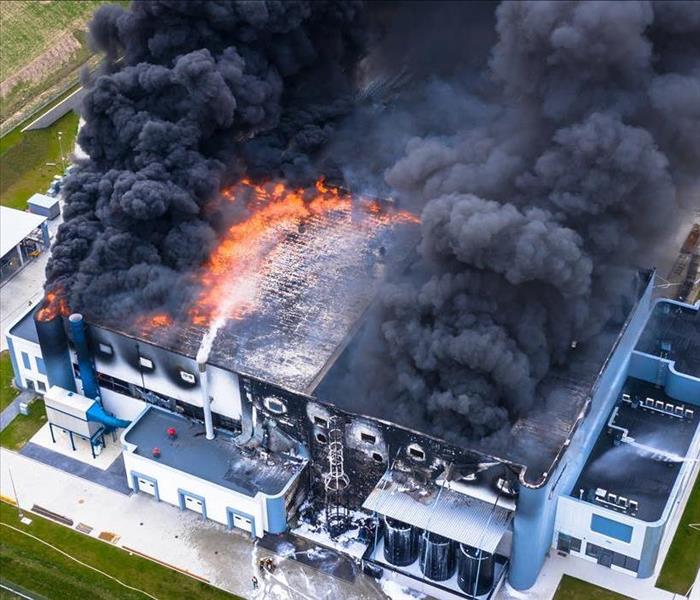 Fire damage in Bountiful, UT.
Fire damage in Bountiful, UT.
A fire can cause plenty of damage to your Bountiful, UT, building on its own. You do not want any additional harm to occur once the blaze has been extinguished. Yet a broken roof leaves your property vulnerable to further damage. That is why you should take extra steps to protect the premises while you wait for the completion of the roof repair. You should also fortify the roof once it has been fixed. If a fire does harm your commercial roof, follow the below tips.
What To Do Before and After the Fire Cleanup
1. Have a Tarp Placed on the Roof
Flames can easily burn through a roof and create a giant hole. Firefighters also often create holes in roofs to eliminate the dark smoke that hinders their visibility.
Leaves and other debris could fall through the holes and into your property. If it rains before the roof is fixed, water could flood your building, as well. Unwanted animals such as raccoons and squirrels could even jump through the hole.
That is why you should hire fire remediation professionals who provide tarp services after a blaze. A tarp will keep the elements and critters outside of your property.
2. Contact Your Insurer
Before the restoration experts perform any significant repairs, you need to contact your insurance company. The insurer will likely send an adjuster to assess the damage before the restoration begins. The adjuster may also request photos and videos of destroyed items. Ideally, the insurer will then work with the remediation company to expedite the claims process.
3. Get the Shingles Replaced
The fire likely destroyed or damaged shingles on your roof. Even if some of the shingles just have missing parts, you should replace them entirely to be safe. The builder who constructed your roof may have left behind some shingles that the restoration company can use. Otherwise, you can find them at your local home shop.
4. Clean the Attic
The fire cleanup experts may need to access your roof through the attic. If the attic is cluttered with debris, this may be more difficult for them. If it is safe to do so, sweep the attic floor and removed any damaged items from the room. Be sure to wear protective clothing with a face mask.
5. Prevent Future Fire Damage With a Steel Roof and Sprinklers
If you need to replace your entire roof, you may want to opt for a steel one instead of a traditional shingle roof. Steel roofs improve your building’s appearance and are energy efficient. They are also more fire-resistant, so they are a great option for companies that often deal with combustible materials.
Installing roof sprinklers is another great way to prevent future fire damage to your building. These sprinklers are particularly useful if your property is in a wildfire-prone area.
Fire cleanup and roof repair can take a long time. Yet if you leave your commercial roof exposed to the elements for an extended period, debris, water or animals could enter the premises and cause further harm. By following the above steps, you should mitigate additional damage.
How SERVPRO Helps With Claims
5/19/2022 (Permalink)
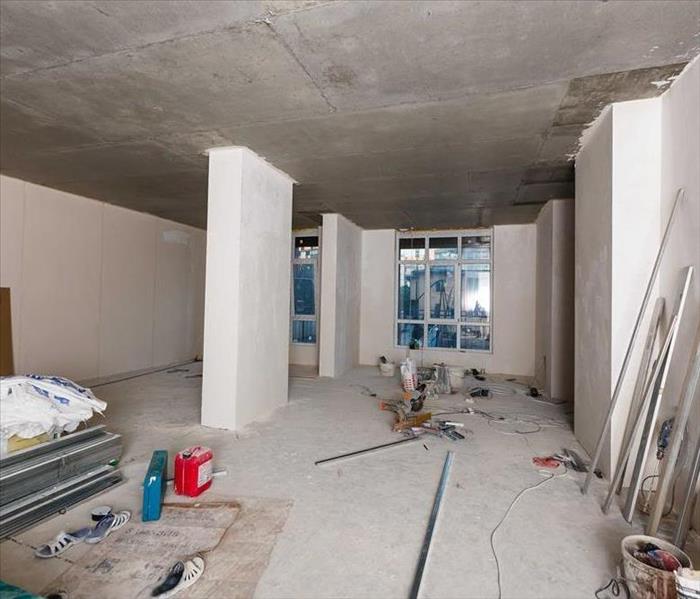 We are here to Help you with your Claims.
We are here to Help you with your Claims.
SERVPRO claims service is dedicated to restoring customers' property and getting them back to business as usual as quickly as possible. Our team can help you settle claims fast, resulting in satisfied customers, lower costs and increased policyholder retention.
SERVPRO Claim Services
There are several reasons to choose our restoration professionals to assist you with your emergency response:
1. Customer Focus
Our priority is restoring your customer's property. Our professionals in Bountiful, UT, work hard to limit your customer's damage.
2. Quick Response
We have over 1,900 locations in the United States and Canada. This allows us to respond quickly at any time of the day or night.
3. Highly Trained Team
All our professionals are trained on Institute of Inspection, Cleaning and Restoration Certification standards for fire and water cleanup and restoration. We also provide continuing education for our professionals and insurance clients at our state-of-the-art IICRC-approved training facility. Our training facility offers employee certification training, new franchisee training, continuing education, e-learning and an IICRC training program.
4. Guaranteed Work
All of our work comes with a two-year labor and one-year materials warranty. We will re-service your customer at no additional charge for up to two years if our service fails to meet commercially reasonable expectations.
5. Cost Savings
Restoring property is usually less expensive than replacing it. We are committed to restoring all of the property that can be restored which saves you money.
6. Documentation Provided
Our team provides all customers with photos of important items and an itemized loss inventory so that your customers can have peace of mind that all of their property is being included in the claim. This also saves you time.
7. Only Qualified Vendors Used
We hold vendors to the same high standards we do our professionals. You never have to worry that we will subcontract work to substandard vendors. Because we handle working with vendors for you, that is one less task you need to complete to close your claim.
8. Dedicated National Accounts Team
We have a dedicated team focused on establishing and maintaining relationships with insurance companies. The goal of this team is to make sure both insurance companies and their customers are highly satisfied with our service.
9. Quality Assurance Guidelines
To ensure our work meets your expectations, we have established guidelines that include internal audits. Local professionals must meet 21 different requirements to get insurance client referrals. All of our employees must pass background checks. We keep communication with insurance agents and adjusters transparent and provide completed job files as proof of work.
10. Many Types of Restoration Services Offered
Our professionals are trained to restore property damaged by water, fire, mold and storms. We also provide specialty cleaning, biohazard services, tarp service, storage, document restoration and crime scene cleanup. Because many disasters involve multiple types of restoration, working with our team can save you time.
Our team works hard to ensure we provide the best claim services in the industry. When you use our restoration services you can rest assured that your customers will receive, fast, professional service that saves time, effort and money.
How To Administer Burn First Aid
5/11/2022 (Permalink)
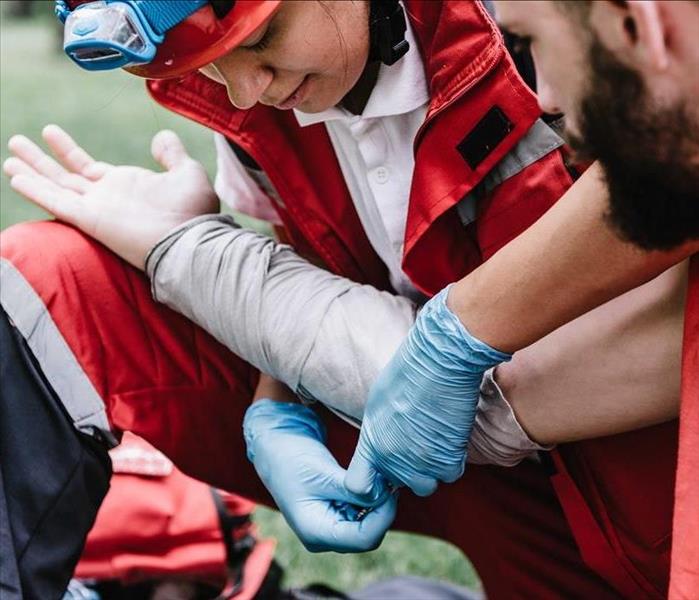 Know more about Burn First Aid by Following Our Tips.
Know more about Burn First Aid by Following Our Tips.
When a fire occurs in your building in Bountiful, UT, you must start your emergency protocol quickly and efficiently. In addition to the fire damage that flames and smoke are likely to cause to your building, you also need to make sure that everyone gets out safely with little to no injury. Sometimes burns do happen, though. It's crucial to know how to respond.
Determining the Type of First Aid Needed
The first thing you need to do before administering burn first aid is to determine how severe the injury is. A minor burn doesn't usually require medical attention. You will need assistance from the emergency response team if the problem shows signs of being severe:
- Charred patches of skin
- Deep wounds that go through multiple layers of skin
- Large burn that is over three inches in diameter
- Abrasion located on a sensitive part of the body such as the face or extremities
- Intense or sudden swelling
Protecting the Injured Person
People with both major and minor burns need to be protected from further injury before anyone begins to administer aid. Follow the evacuation procedures you have practiced to help them get clear of the building that has fire damage. Then make sure they are comfortable and that all their vital signs such as breathing and body temperature remain as close to normal as possible.
If clothing is stuck to the burn, do not attempt to remove it, but you can help the victims take off constricting jewelry or other items that may get in the way of treatment.
Treating a Minor Burn
A small, minor burn that shows only red skin or a few blisters doesn't necessarily need medical intervention. Keep it cool, clean and covered. Run it under cool water or lightly pat with a damp rag to reduce the heat. Use a first-aid ointment to clean the area gently. Cover it loosely, careful not to pop the blisters, so that it is protected from the air and anything it may carry.
Finally, the burn victim can take an over-the-counter medication designed to reduce pain, fever and swelling to help relieve discomfort.
Dealing With a Major Burn
Fire restoration experts know how quickly flames can destroy a building. A raging fire can also injure anyone caught in its path. When people show signs of a major burn, there is not much a person without medical training can do for them. You should loosely cover the burn with a clean cloth to protect them from further injury until the emergency team arrives.
Don't leave them unattended, just in case they go into shock or need your assistance. Wait for them until the ambulance arrives and then let the EMTs take over.
Knowing the right evacuation routes to get out of a building with fire damage is important. Understanding how to administer aid for burns is crucial, too. The more people there are in your building who know the basics, the better chance everyone has of getting out of the fire mostly unscathed.
Answering Common Questions About Partial Fire Losses
4/13/2022 (Permalink)
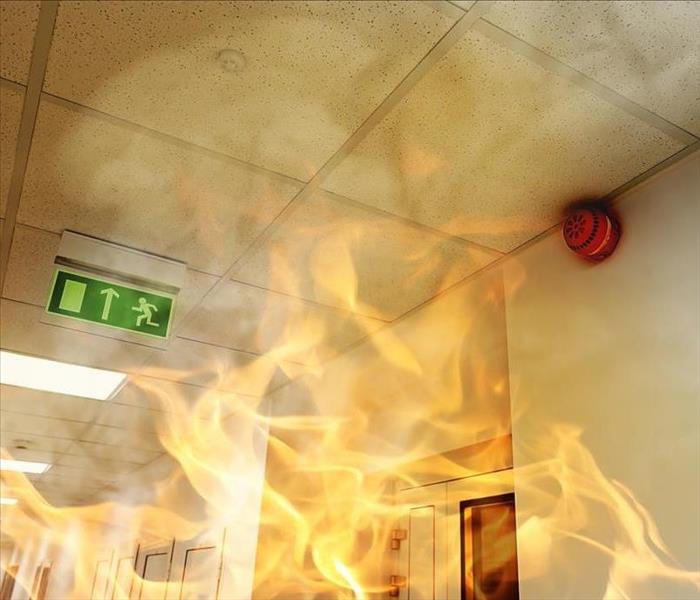 If you have Questions About Partial Fire Losses, take a look at These Tips.
If you have Questions About Partial Fire Losses, take a look at These Tips.
Not every commercial blaze results in the total destruction of a property. You could end up with a partial fire loss, instead.
A partial loss can also occur if there is damage to an adjacent building. The smoke or extreme heat could migrate toward your property. The fire retardant used by first responders could harm your premises, as well. Whether the partial loss results from a fire in your building or a nearby one, there are some things you should know about making an insurance claim.
Common Questions About Partial Fire Losses
Should You Get the Property Inspected for Fire and Smoke Damage?
Sometimes, the damage caused by a fire is obvious. However, this is not always the case. If there has been any kind of blame in or near your Bountiful, UT, property, you should get it inspected by a qualified professional.
Your insurance provider will likely send an adjuster to survey the area. Yet this is not sufficient. You should also hire a structural engineer or contractor to evaluate the structural integrity of the building. You may also want to bring in an industrial hygienist to check the air quality. This is particularly important if you or any of your employees have asthma or severe allergies. Ideally, the inspection should cover:
- Windows
- Roofing
- Interior Walls
- Heating and Plumbing Systems
- Concrete and Siding
The inspector should also estimate the cost of fixing your premises. You will likely need to hire fire restoration professionals to clean the property and repair any damaged assets.
Will Your Insurance Pay for Mold, Smoke and Ash Cleanup?
A fire loss does not only include the harm caused by the blaze itself. There could also be ash or smoke damage. Rugs, curtains and fabrics could develop lingering odors. The ash could also stain tile or marble.
If the flames caused your building's sprinkler system to activate, the water from those sprinklers could encourage mold growth, as well. Mold can be particularly prevalent on wet drywall. Any fire-related holes in your walls or roof could additionally allow rain to enter the property, potentially sparking a mold infestation.
Will your insurance pay for these damages?
It depends on your policy, but ash and smoke are typically covered. Any porous materials should be given to a restoration professional. The expert can then help you decide whether the items can be salvaged or should be replaced.
Mold damage, however, is not always covered by insurance. Many companies have mold exclusions, so you will have to talk to your adjuster or read over your policy to find out if you have any coverage.
Will Insurance Cover Landscaping Damage?
The smoke and heat from the fire could also destroy any plants outside your property. Your policy should have some coverage, but it may be limited. For instance, most policies only pay $500 for each damaged tree, yet a mature tree can be worth several thousand dollars. Some plants may appear fine after the fire yet die over time. You should thus keep open your insurance claim for several months in case you have to make any additions to it.
A partial fire loss can still be quite expensive. Thankfully, a decent commercial insurance policy should cover at least some of the costs.
Is Your Commercial Property Impacted by Storm or Flood Damage?
3/9/2022 (Permalink)
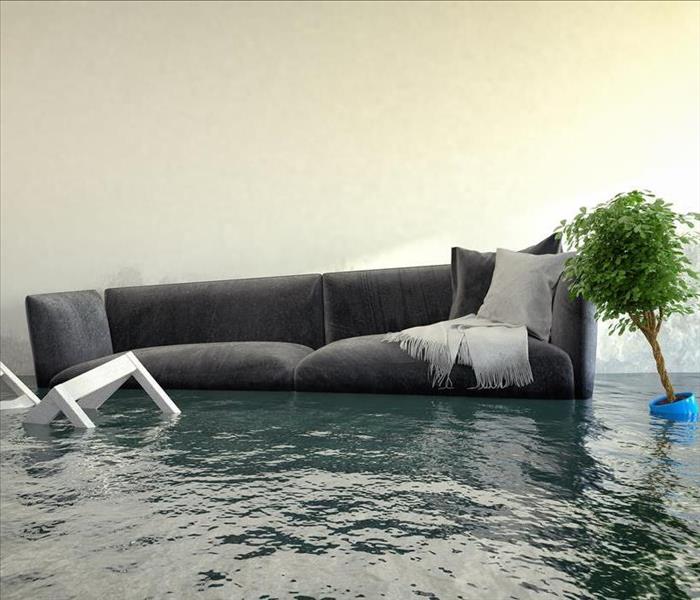 If you experience Storm or Flood Damage in your Commercial Property, do not heasitate and Contact us.
If you experience Storm or Flood Damage in your Commercial Property, do not heasitate and Contact us.
According to the Insurance Information Institute, flood damage remains a prominent issue within the United States, noting that the cost of water repair has quadrupled since the 1980s. Some of this harm stems from water breaks and sewer overflows. However, business owners also face devastation from other external sources such as weather events. These cases can result in a damp, potentially expensive mess.
The source of the dampness matters, though. Is it really from a flood or the storm? Owners may think it doesn't matter, requesting a dry out and cleaning. However, circumstances vary for each situation and in working with restoration and claim procedures; therefore, it's critical that proprietors in Bountiful, UT, know the difference, seeking appropriate remediation for the harm. The following are distinctions between the two events.
What Qualifies as Flood Damage?
Flood water is considered a rise in a body of water such as a river, ocean or lake. It comes from the outside to the inside of the building. The overflow may occur during a storm, but the harm itself comes from the external body of water.
The Federal Emergency Management Agency, FEMA, recognizes a flood as any of the following circumstances:
- A runoff or fast spread of water
- The breakdown or erosion of land that leads to excess water
- Mudslides
- Spilling over of tidal waters
For instance, rains might fill up a nearby retention pond during a hurricane. As a result, the water leaves its location, entering a nearby property and causing heavy saturation to the walls and floor. It could even ruin structures and products. The storm led to the overflow, but the damage was from flooding, not the weather. Insurance, therefore, would classify this event under flood coverage.
What Damage Occurs From a Storm?
Storm destruction results from weather-related occurrences, creating water or other physical complications. It's usually from above and, unlike floodwater, not from the ground. For instance, a storm might affect the roof, windows, electrical or plumbing. Moisture or other complications happen from that event. Common problems would include any of the following:
- Shingle damage
- Moisture entering from exterior exposure
- Fallen trees breaking windows, roofs or walls
- Lightning strikes that ruin electrical wires or business systems
Why Know the Difference Between the Two?
Water isn't always the same, and your insurance policy notes that. Commercial property insurance often includes storm damage but not flood coverage. Floodwater falls under an add-on policy, purchased separately. Business owners, therefore, need to know when they can file a claim with their agent.
A water restoration company may evaluate the wetness, determining the underlying cause. This overview proves helpful in learning how to manage the mess, sanitize the property and rebuild the location. In addition, business owners may use the assessment to collaborate with their insurance firms, concluding how to file and seek compensation appropriately.
Tend to storm and flood damage as soon as possible to mitigate potential issues and get back to business. Be sure to learn the underlying cause of the problems and work with professionals to remediate the issues.
How To Perform Fire Sprinkler Maintenance
2/17/2022 (Permalink)
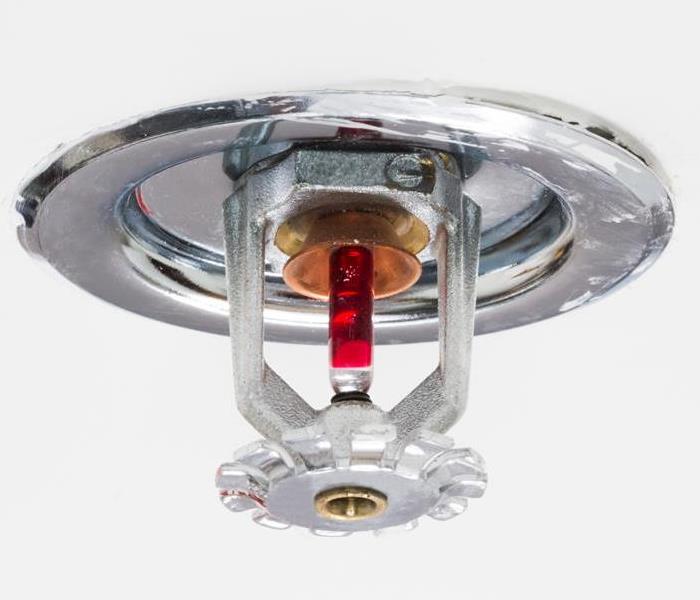 Follow these tips to ensure your Fire Sprinkler Maintenance. If you have any doubt, just contact us.
Follow these tips to ensure your Fire Sprinkler Maintenance. If you have any doubt, just contact us.
As a building and property manager, you have many responsibilities. Tenants expect you to maintain the property to ensure all safety features and utilities work correctly. Fire sprinkler maintenance should be chief among safety checks, according to fire remediation specialists in Bountiful, UT. These checks should include:
- Control valves
- Sprinkler heads
- Water pressure
Additionally, management needs to ensure that tenants know how to work around fire prevention systems. If you are in building management, there are at least five steps you need to take to ensure sprinkler systems remain functional and effective.
The 5 Steps of Fire Sprinkler Maintenance
All systems of fire sprinklers are similar but different. Before you delve into the five steps and self-assessments, check with the manufacturer or manual for your respective system. The following list is meant as a general overview of essential sprinkler maintenance and inspection.
1. Check Control Valves
Non-electric control valves essentially have two positions: open and closed. If the valves are closed, no water can get to the sprinklers, meaning the system is worthless if a fire breaks out. The valves should always remain open. Unfortunately, you never know when someone might mistakenly close the valves with tenants. Therefore, you should get in the habit of checking the valves weekly.
2. Clean Sprinkler Heads
As sprinklers are stationary and open to the environment, they tend to collect dust and debris. In kitchens, the heads can become coated with grease. As management, your job is to ensure the heads remain clean to avoid any impedance if a fire occurs. Additionally, it would be best if you never painted over a sprinkler.
3. Check Water Pressure Quarterly
For a sprinkler system to do its job, it requires adequate water pressure. Unfortunately, checking water pressure is not something most building managers or owners are trained to do. Therefore, you will probably need to bring in a plumbing or fire professional to check the pressure. This is a job that should be performed at least four times per year.
4. Clear Space Directly Under Sprinklers
Tenants will not always know how to work around sprinkler systems, so it is up to the property manager to inform them of what is and is not Ok. One common mistake tenants make is positioning shelving or tall furniture directly underneath the heads or the system. While the location of the furniture might suit the tenant, it obstructs the effectiveness of the sprinkler. Sprinklers are designed to cover a specific area with water. When a piece of furniture is blocking its head, the water will not cover as much of the site as it is supposed to.
5. Call Professionals for Annual Inspections
DIY inspections have their place, but since you are not a professional, hiring a company to assess the system at least once per year is best. The professionals will perform all the routine inspections above and more to ensure your system is operating as it should.
Commercial fire sprinkler maintenance is essential to a functioning and safe facility. When was the last time you had a professional inspection at your building?
How To Keep Mold From Returning
2/2/2022 (Permalink)
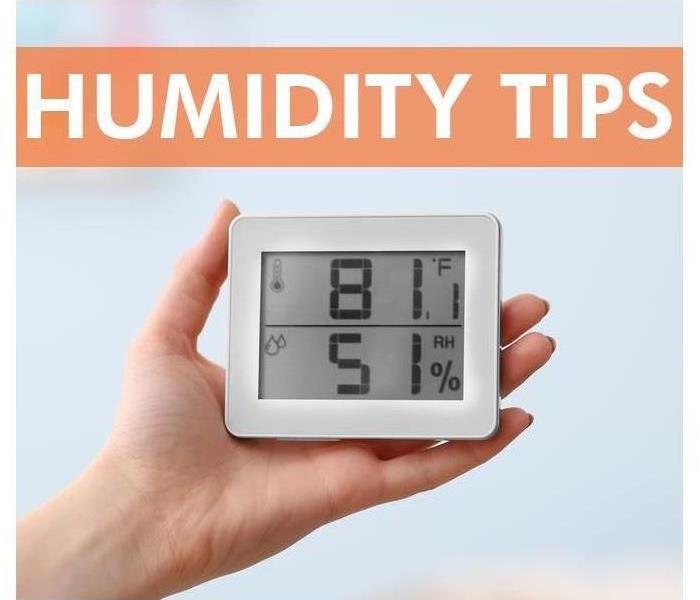 The humidity in your building should range between 30-60% to decrease mold growth
The humidity in your building should range between 30-60% to decrease mold growth
Mold spores in the air tend to settle on surfaces that have lingering water. You may have the mold growth removed, however, only to find that it returns to the exact same spot. There are several reasons why this might occur in your commercial property in Bountiful, UT, and identifying the cause is essential to preventing repeat growth from occurring.
Consider these causes to avoid Mold Damage
Humidity
There are four things mold needs to grow:
High humidity levels in your building can create the ideal environment for fungus. You can place several dehumidifiers in various locations around the building to bring the level down. By maintaining 40 to 50 percent humidity in your building at all times, you can lower your risk of mold growth.
Hyphae
The growth pattern of mold can make it hard to get rid of for good. Not only does it grow across a surface, but it also tends to grow down into the item on which it thrives. Hyphae are the tendrils that branch into the pores of the affected item. Even if you clean the surface with detergent and a clean cloth, mold may return. Only thorough professional mold remediation is able to extract hyphae out of the crevices into which they grow.
Damage
Water damage that has not been properly remediated is another likely cause of the return of mold patches to a previously affected area. Mold can start to grow in as little as 24 hours after the damage has occurred. The best way to prevent secondary damage is to repair the structures quickly. As soon as you know that a leak has saturated your floors, ceiling, or walls, you should call professionals to have the problem remedied.
Just because you can't see mold, that doesn't mean it won't return. Once you eliminate causes such as humidity, incomplete remediation, and water damage, you are more likely to be able to prevent future mold growth in your building.
Steps To Take After a Pipe Breaks
1/18/2022 (Permalink)
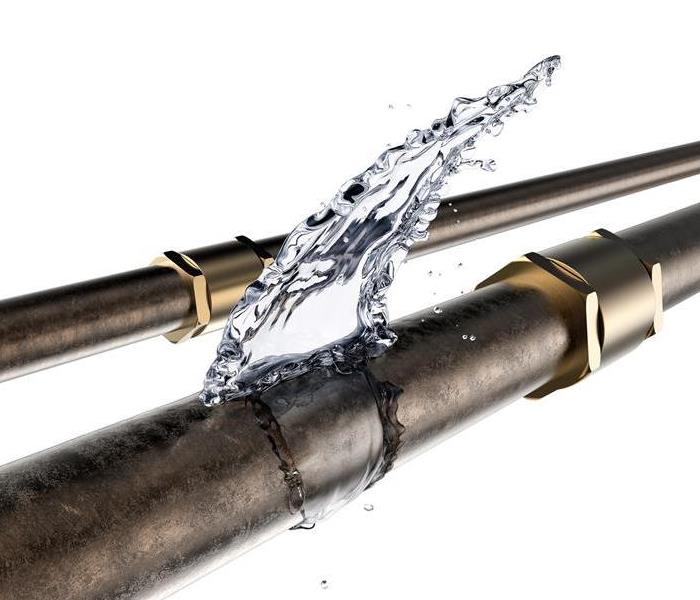 Water damage can make a real mess. If any problem related to this occurs, do not hesitate to contact us.
Water damage can make a real mess. If any problem related to this occurs, do not hesitate to contact us.
Bursting pipes in your commercial building can cause a lot of damage before you even know there's a problem. When this happens, you need to act quickly to minimize damage to the building and keep repair costs as low as possible.
Here are a few steps you need to take as soon as you are aware of a busted pipe.
Turn Off Water Main
The first thing you need to do when you discover any major leak is to shut down the water source. For most buildings, this is going to be the water main. This action accomplishes several things:
- Halts the flow of water to the broken pipe
- Relieves pressure on other pipes to keep them intact
- Gets the building ready for repair
Call Repair Professionals
The next step is to get repairs started as soon as possible. Call a local plumber who can come out and fix the broken pipe. After all, it doesn't do any good to repair the damage around it if the pipe spews water again after it's turned back on! You also need to call water damage restoration specialists to mitigate any problems with the building that are caused by the leak. When they arrive on site, they assess the damage and make a plan to address it. If you hire a company that takes care of both mitigation and restoration, you don't have to worry about making sure both teams keep each other informed.
Drain Pipes
While you are waiting on the plumber and the mitigation team to arrive, you can take an extra step to prevent additional problems with bursting pipes, especially if temperatures outside are below freezing. Turn on the faucets and flush the toilets to remove all the water that remains in them. That way, even if other pipes freeze overnight, there's no water in them to cause a break.
Document Damage
Your mitigation team will give you an itemized list of what needs to be done to fix the water damage in Bountiful, UT, but it doesn't hurt to have your own documentation. Take pictures and videos of the affected area so that you have proof to back up the things you list on your insurance claim. If you can safely do so, it's a good idea to accompany the adjuster and the mitigation assessor when they survey the building to gain a better understanding of all the repairs that are needed.
Upgrade Prevention Measures
The best solution to busted pipes is to prevent them from happening in the first place. While you are waiting on repairs to be finished, buy supplies to insulate the rest of your pipes, particularly the ones that are located along external walls. Make sure your thermostat remains no lower than 55 degrees overnight to help keep pipes warm. While the plumber is there, ask him or her to inspect pipes for small pinhole leaks and repair them before they get larger and cause a lot of damage.
Water damage from bursting pipes can make a big mess. With swift action and the right professional help, you should be able to get your building back in order in no time.
How To Mitigate Water Damage
1/11/2022 (Permalink)
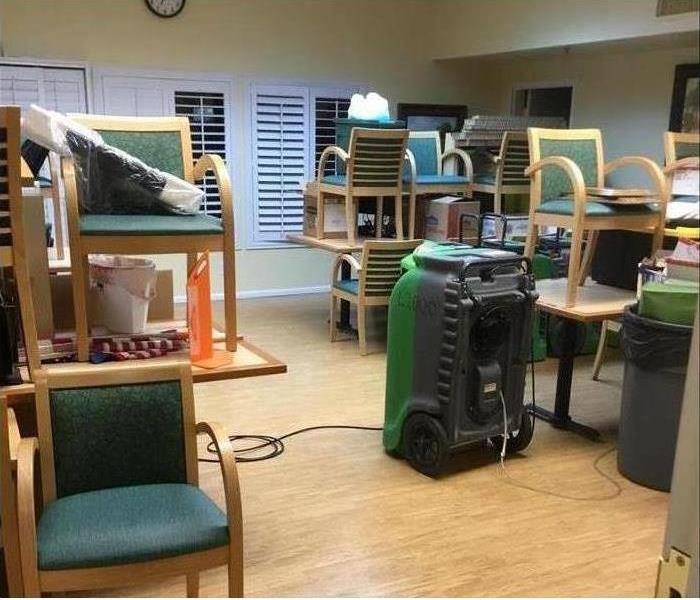 Commercial water loss in Bountiful, UT
Commercial water loss in Bountiful, UT
Mitigation should begin as soon as a property owner or manager notices signs of water damage. Whether you discover a supply line leaking or you need a pipe burst cleanup, these water cleanup measures can limit the severity of the damage.
Steps To Mitigate Water Damage
Address the Cause
Damage is likely to worsen until the cause is fixed. Take the following mitigation measures:
- Turn off the water supply
- Collect water in containers
- Contact a plumber
These steps can limit the severity of water damage. Once the problem is fixed, cleanup can proceed.
Remove Standing Water
Water left standing will damage contents. Depending on how much water is present, you may need to use towels and a mop, a wet vac, or a pump. If you do not have equipment capable of handling a pipe burst cleanup, contact a water damage cleanup service. Mitigation professionals can quickly address primary and secondary damage.
Clean and Disinfect
It may be necessary to clean or disinfect the damaged area. The treatment required depends on the conditions where the leak occurred and the category of water damage. You will need to
- Dry Category One damage
- Clean and disinfect Category Two damage
- Clean and disinfect Category Three damage
Category One water is clean and treated. Category Two gray water is contaminated but does not contain solid waste. Category Three black water is highly contaminated and may contain sewage.
Dry the Area
It is necessary to dry the affected area regardless of the category of water damage. You may use air movers, dehumidifiers, or fans. This equipment will promote faster drying and draw moisture out of porous surfaces. Drying can limit the severity of water damage.
The owner or manager of a commercial property should fix the cause of water damage as soon as possible. If pipe burst cleanup or other major mitigation measures are necessary, hire a water cleanup service located in Bountiful, UT.
How Flood Water Becomes Black Water
6/18/2021 (Permalink)
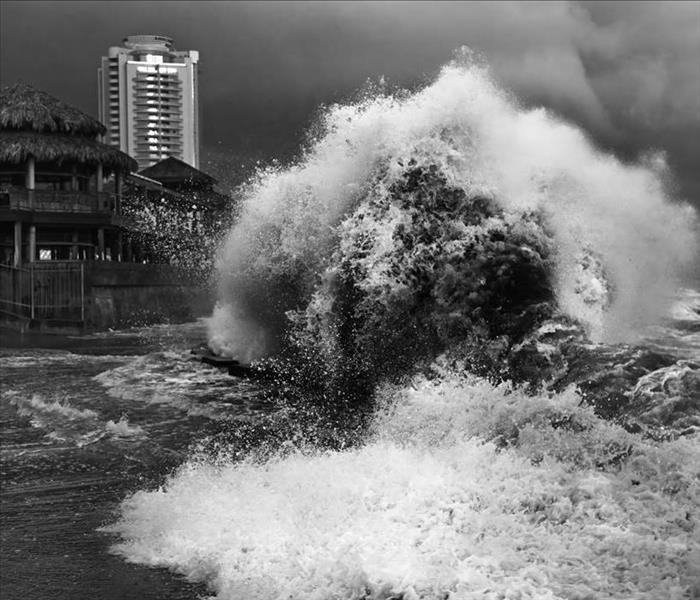 Heavy storms can lead to severe flooding damage.
Heavy storms can lead to severe flooding damage.
In the confusion after a flood, deciding what type of water is contaminating your business is difficult. To keep your customers and employees safe, you need to consider any flood water as dangerous. There are three basic types that you need to worry about.
- White water - clean water flooding
- Grey water - contaminated water without fecal or other dangerous matter
- Black water - highly contaminated water with fecal matter or other harsh bacteria-producing chemicals. This is the most common type of commercial storm damage.
Each type of water requires different a different type of cleaning. Floodwaters usually are classified as black. This is the most dangerous type and needs to be cleaned as soon as possible. In this case, it is best to hire a professional remediation company in Bountiful, UT, to avoid the risks associated with flooding.
Black Water Is The Most Dangerous
It Contains Outside Materials
Flood water from a storm almost always contains things that make it hazardous. This is particularly true if your business is on septic or there are septic fields in your area.
Flooding occurs when a body of water inundates the ground and surface to the point of peak saturation. Once this point is reached, the water seeps above the ground, causing the flood.
When the ground is saturated, it also pushes contaminates up from the soil. This means fecal matter, bacteria, and other contaminants come up from the ground, regardless of whether your business is on septic or city water. These can enter your location and damage porous surfaces causing mold, mildew and infections.
It Can Cause Sewer Failure
Even if you do not have a septic system, your city sewers can fail when it suffers storm damage. This often causes pipes to break and sewage to come to the surface. Sewage can cause mold and bacterial contamination.
When a sewer system fails, you may be required to boil your water. This is because it may contain the dangerous bacteria associated with black water.
It May Sit For Long Periods
Any water that sits for any length of time can go from clean water to contaminated water very quickly, particularly if you live in a warm climate.
Any time you have flood water, you should automatically consider it contaminated. This means treating it like it is hazardous.
Tips for Handling Water Damage
5/25/2021 (Permalink)
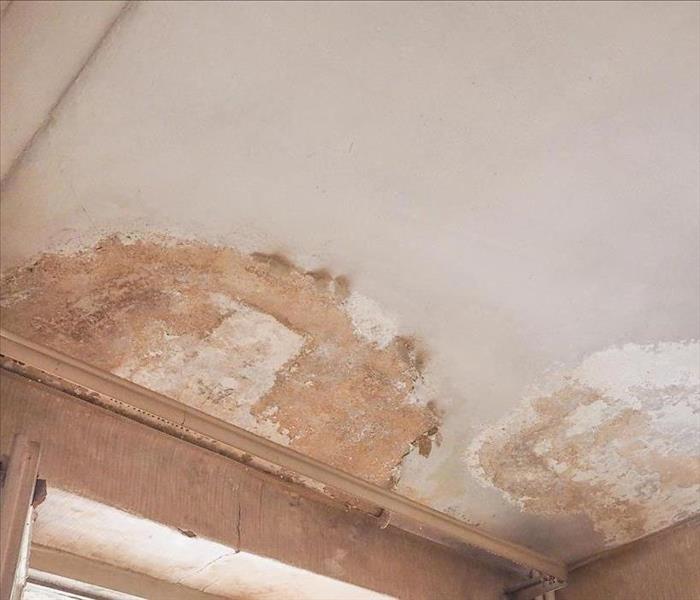 Commercial water damage
Commercial water damage
Having a regular inspection and maintenance schedule for your building in Bountiful, UT, is an important part of property ownership. Despite your best efforts, however, sometimes water damage still occurs. When that happens, there are several things you need to do as soon as possible.
2 Things You Need To Do To Handle Water Damage
Make Important Calls
The first thing to do when your building has damage from broken pipes or storm overflow is to call for help. Depending on the source and the severity of the problem, there may be several professionals you need to contact:
- Insurance provider
- Water restoration specialists
- Plumber
- City officials
Get restoration started as quickly as possible, and make sure you are not causing more damage or violating any regulations in the process. Calling for backup help is the best way to confirm that you are handling the problem properly.
Enact Contingency Plans
It's smart to have a plan for business continuity during emergency events. If the water damage in your building is widespread, you may have to relocate temporarily in order to keep your business going. The more detailed your plan is, the more readily your employees are able to adjust to their new work alternatives.
Leave Cleanup to the Professionals
The water cleanup process involves removing excess water, drying and cleaning the affected area and replacing anything that has to be discarded. While you may have the urge to help out, the most beneficial thing you can do is step aside and let the people with the proper training and equipment handle it. Focus on keeping your business afloat, and leave the restoration process to them.
It's normal to feel overwhelmed when your building sustains a lot of water damage, but there are a lot of people who can help you navigate the cleanup process. Knowing the first steps to take can help you get the mess cleaned up and get back to business as usual as soon as possible.
What's Causing the Sewage Odor in My Building?
4/12/2021 (Permalink)
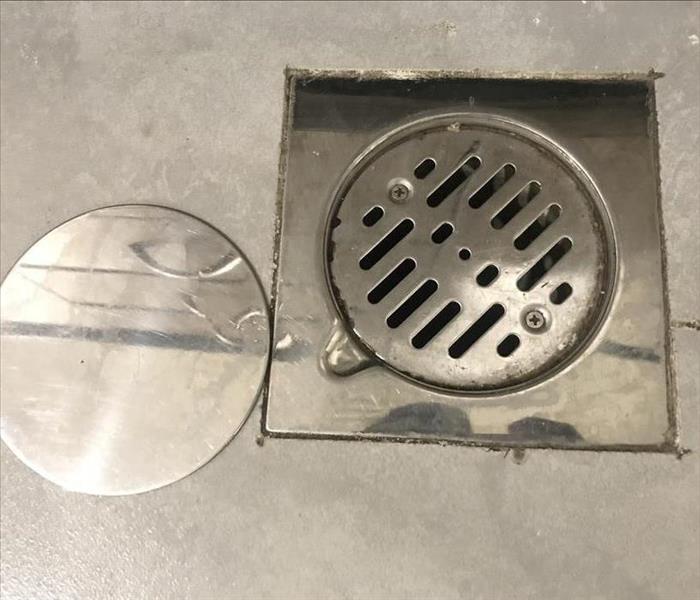 Clogged drains can cause sewage odor.
Clogged drains can cause sewage odor.
Do you have a mysterious rotten egg odor wafting around your Bountiful, UT, building? It could be sewer gas from the sewage system. Decomposing waste materials produce a fusion of putrid chemicals, including ammonia, hydrogen sulfide and methane. There are several reasons this sewer smell could be released into a building.
5 Reasons For Sewage Odor
1. Faulty Toilet Ring
One of the most straightforward explanations for this problem could be a faulty or worn wax ring under the toilet. If you notice the toilet rocking or small leaks at its base, there's a good chance the wax ring isn't fitting correctly and needs to be replaced.
2. Leaky Sewer or Septic Line
You might notice a foul odor, along with your toilet and/or drains making gurgling sounds or draining slowly. These are reasonable indications of a sewer or septic line leak.
3. Backed Up Sewer or Septic Line
Sewer and septic lines can become obstructed, which can cause a sewage backup into your building. This can cause a foul sewer smell in the building and damage to your flooring and other materials. If the building sustains damage, you should hire water cleanup experts to clear, clean and sanitize the affected area.
4. Dry Water Traps
Water traps (aka P-traps or S-traps) are typically located near floor drains and underneath sinks. They're designed in a curved shape to trap water in the arch. This design is supposed to block sewer gas from entering the building. However, if there's no water in the trap, the gas has a free path to inside of the building.
5. Clogged Air Vent or Drain
Air vents can become clogged with debris and other blockages. These obstructions can prevent sewer gases from escaping from the vents outside. As a result, the gases travel into the building.
If you notice a sewer smell in your building, it's probably time to call a plumber to assess the issue. A sewer leak or backup could turn into a significant and expensive disaster if it's not controlled immediately.
Routine Maintenance for Commercial Fire Sprinkler Systems
3/16/2021 (Permalink)
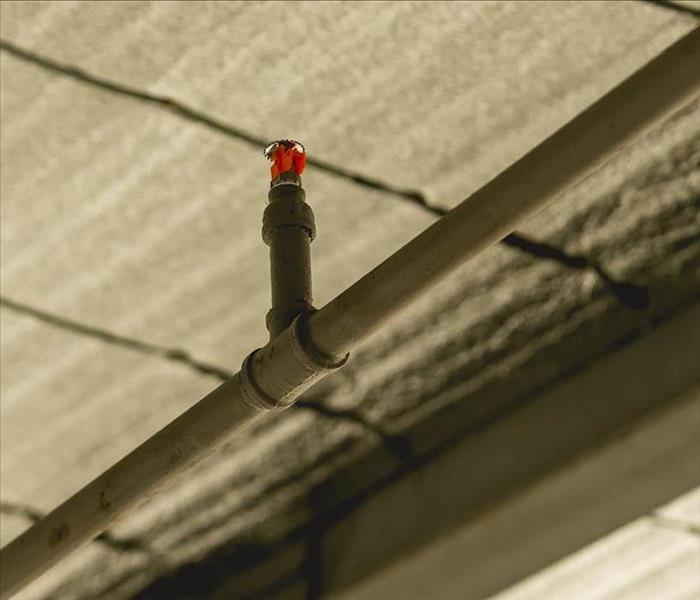 Fire Sprinkler Systems need routine maintenance
Fire Sprinkler Systems need routine maintenance
The fire sprinkler system has several components, such as a source of water, pipes that carry the water, and several sprinkler heads. When heat or smoke triggers the system, water is automatically discharged over a specific area. Thus, the system acts as both a detector and a suppressor. This only happens, however, when the sprinkler has been maintained properly and is ready to go.
Maintenance Routine for Fire Sprinkler Systems
Inspection and Maintenance Standards
The National Fire Protection Association provides guidelines to guide the maintenance and care of fire sprinkler systems. These are grouped under the heading HFPA 25 and cover the following areas:
- Inspections
- Maintenance
- Testing
Facility management teams should look these standards up and become familiar with them. With knowledge of the maintenance steps, it is possible to avoid damage and malfunctions.
Weekly Visual Inspections
The weekly inspections shouldn't take long, and they don't often require any tools:
- Inspect the gauges by reading the water pressure and air indicators. These should be within the normal range as suggested by the NFPA standards and system manufacturer.
- Start your visual inspection of control valves by reading the signage and then checking for leaks.
- Verify that the valves are locked, sealed, and set in the open position.
Monthly Inspections and Tasks
Monthly inspections for your fire suppression system may vary a bit depending on which types of system is installed in your Bountiful, UT, facility:
- The gauges on wet pipe systems must be checked for proper levels of water pressure.
- Alarm valves must be inspected for damage.
- Review the fire safety plan for the facility and ensure that signs are posted and easily seen.
Quarterly Maintenance and Inspections
On a quarterly basis, in addition to completing weekly and monthly tasks, it's important to complete the following checks:
- Make sure alarm devices aren't damaged.
- Test alarm devices to be sure they function properly.
- Make sure the hydraulic nameplate is secure, and the information is legible.
Damage Prevention
Fire sprinkler systems are effective at detecting fires and putting them out before your Bountiful, UT, buildings suffer expensive damage. When damage does occur, reach out to fire sprinkler cleanup professionals.
How Is Category 3 Water Damage Remediated?
2/11/2021 (Permalink)
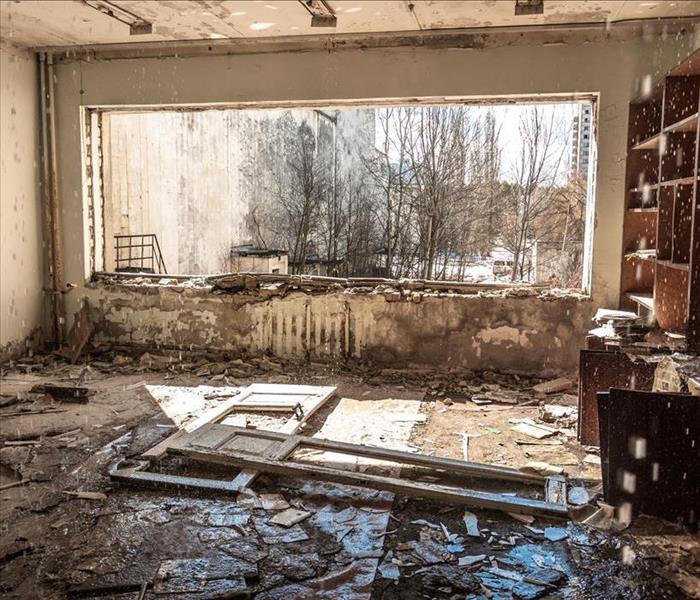 Category 3 water damage.
Category 3 water damage.
Although some materials will be damaged by water no matter how clean, all floods are not alike. Flood water damage is broken down into category 1, category 2 and category 3, with category 3 damage being the most serious. Categories 1 and 2 can, however, escalate to category 3 if it sits for a time.
What Is Category 3 Water Damage?
Category 1 water (aka clean water) poses no harm to you or your property. Category 2 water (aka gray water) has some biological or chemical contamination. Category 3 water (aka black water) is exceptionally unsanitary, containing known toxic contaminants like bacteria and viruses. Common examples of black water are:
- Sewage water (e.g., from a toilet overflow)
- Rising water (e.g., from groundwater after a heavy downpour)
- Flood water (e.g., river water, stream water, seawater)
Water damage remediation professionals must manage category 3 damage to ensure safe and proper cleanup.
What Does the Remediation Process Involve?
When the professionals arrive on the scene, they'll be wearing the proper personal protective equipment to preserve their well-being and prevent cross-contamination to unaffected areas of the building. The first part of the cleaning process is removing the standing water. This is usually accomplished with an industrial wet/dry vacuum. Next, it's time to remove all damaged materials. In category 3 disasters, typically, nearly everything will have to be disposed of due to the contaminants. Thorough cleaning and sanitizing the entire affected area is essential, including tiny cracks and crevices where water can get trapped. The site must then be dried thoroughly and as quickly as possible to prevent mold growth. The professionals will use industrial-grade equipment such as fans and dehumidifiers to dry the area as efficiently as possible.
After any kind of flood water damage occurs at your Bountiful, UT, building, it's critical to have the area and its contents thoroughly cleaned and dried. The quicker the response, the less damage you can expect.
3 Reasons a Security Fence Is Necessary After a Commercial Fire
1/19/2021 (Permalink)
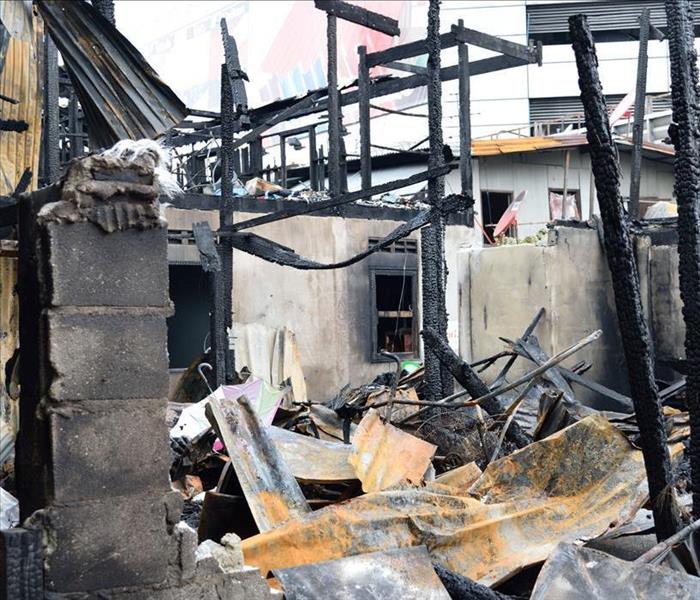 Commercial fire damage.
Commercial fire damage.
There are many things to consider after a commercial fire: inventory loss, property damage, employee safety, etc. When contacting an insurer to report damage, a business owner might receive advice to contact a fire restoration specialist in Bountiful, UT, to assess and suggest ways forward. Most of these companies will suggest the installation of a security fence, especially when damage is severe, and they will suggest it for at least three reasons.
3 Reasons To Install a Security Fence After a Commercial Fire
1. Insurance
Most insurers will require policyholders to mitigate further damage to the property after the initial commercial fire report. If a business owner fails to prevent or attempt to reduce other losses, their insurer may deny the claim. The installation of a temporary fence and other mitigation measures shows your insurer that you take the recovery process seriously and do not take your policy for granted.
2. Vagrants
Without a security fence, your property can become a home or playground to vagrants and other people curious to inspect the damage. While there might be few elements of value left in your facility for theft, having a stranger roaming an unsafe property puts your business at risk. If one of these people become injured, your company could be liable for their injuries, primarily if no effort is taken to secure the property. A fence and other mitigation tactics demonstrate your commitment to safety.
3. Wildlife
Fire damaged buildings are susceptible to damage from weather, vagrants, and wildlife. While concern over animal safety might not be at the top of your list, the destructive risk and danger wildlife present to your facility and restoration workers should. A fence of appropriate height and strength can prevent animals from entering your property and attempting to nest or hunt, keeping the building and workers safe.
While a security fence might not be the primary concern for a business owner after a commercial fire, it is an essential mitigation tool. After the safety of their workforce, a property owner’s primary concern must be on protecting and rebuilding their enterprise, including the securing of insurance funds.






 24/7 Emergency Service
24/7 Emergency Service














